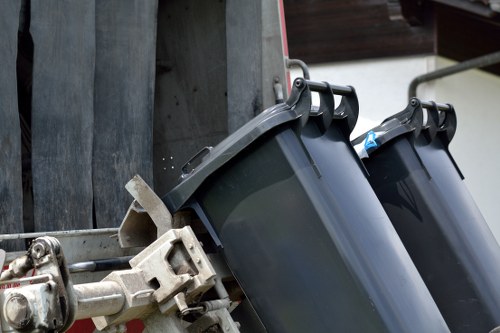Comprehensive Guide to Demolition Waste Removal in Soho

When undertaking a demolition project in Soho, managing waste effectively is crucial. **Demolition waste removal** not only ensures a clean and safe environment but also complies with local regulations. Soho, known for its vibrant urban landscape, requires specialized waste management solutions to handle the diverse types of debris generated from demolition activities.
Proper disposal of demolition waste helps in minimizing environmental impact and promotes recycling of materials such as concrete, metal, and wood. By choosing the right waste removal services, you can ensure that your demolition project proceeds smoothly and sustainably.
In this article, we will explore the various aspects of demolition waste removal in Soho, including the types of waste generated, the importance of proper disposal, and the best practices to follow. Whether you are a homeowner planning to renovate or a contractor handling large-scale demolitions, this guide will provide valuable insights to manage your demolition waste efficiently.

Understanding Demolition Waste
Demolition waste consists of materials that are left over after the dismantling of structures. In Soho, demolition projects can range from residential buildings to commercial complexes, each generating different types of waste.
Common types of demolition waste include:
- Concrete and Masonry: These materials are among the most prevalent in demolition projects and can be recycled for use in new construction.
- Metals: Metals like steel and aluminum can be salvaged and reused, reducing the need for new mining.
- Wood: Wood debris can be processed into mulch or used for other construction purposes.
- Asbestos: Special handling is required for asbestos-containing materials to prevent environmental contamination.
- Glass: Glass waste can be recycled and used in various industries.
Identifying and categorizing waste is the first step in effective demolition waste removal, allowing for tailored disposal and recycling strategies.

Benefits of Proper Waste Removal
Effective demolition waste removal offers numerous benefits for both the environment and the community.
- Environmental Protection: Proper disposal reduces the risk of pollution and conserves natural resources by enabling recycling.
- Regulatory Compliance: Adhering to local waste management regulations prevents legal issues and potential fines.
- Cost Efficiency: Efficient waste removal can lower overall project costs by minimizing landfill fees and maximizing material reuse.
- Enhanced Safety: Removing debris promptly ensures a safer worksite, reducing hazards for workers and the public.
- Community Aesthetics: Keeping demolition sites clean maintains the visual appeal of Soho’s urban environment.
Investing in proper waste removal is not only beneficial for immediate project success but also for long-term sustainability and community well-being.

Choosing the Right Demolition Waste Removal Service
Selecting a reliable waste removal service is essential for the success of your demolition project in Soho. Here are some factors to consider:
- Experience and Expertise: Choose a company with a proven track record in handling demolition waste in urban settings like Soho.
- Licensing and Insurance: Ensure the service provider is properly licensed and insured to cover any potential damages or accidents.
- Recycling Capabilities: Opt for providers that prioritize recycling and can process various types of demolition materials.
- Timeliness: Prompt waste removal services prevent project delays and maintain site cleanliness.
- Transparent Pricing: Look for companies that offer clear and competitive pricing without hidden fees.
By carefully evaluating these factors, you can select a demolition waste removal service that aligns with your project’s needs and sustainability goals.

Steps in Demolition Waste Removal
Effective demolition waste removal involves several key steps to ensure efficiency and compliance.
1. Assessment and Planning
Begin by assessing the site to identify the types and quantities of waste. Develop a waste management plan that outlines the strategies for sorting, recycling, and disposal.
Key Considerations:
- Types of materials to be removed
- Recycling opportunities
- Regulatory requirements
- Timeline and budget
2. Sorting and Separation
Segregate waste into different categories such as concrete, metal, wood, and hazardous materials. Proper sorting facilitates recycling and reduces landfill usage.
Best Practices:
- Use separate containers for each type of waste
- Employ trained personnel for handling hazardous materials
- Label containers clearly for easy identification
3. Transportation
Transport the sorted waste to appropriate recycling facilities or landfills. Choose transportation methods that minimize environmental impact and comply with local regulations.
Transportation Tips:
- Select eco-friendly vehicles when possible
- Ensure proper documentation for waste transfer
- Coordinate schedules to avoid delays
4. Recycling and Disposal
Recycle materials wherever possible to conserve resources and reduce waste. For non-recyclable materials, use environmentally responsible disposal methods.
Recycling Strategies:
- Partner with local recycling centers
- Implement on-site processing for initial sorting
- Educate workers on recycling protocols
5. Site Cleanup
After waste removal, thoroughly clean the site to ensure it is safe and presentable. Proper cleanup enhances site aesthetics and prepares it for future use.
Cleanup Checklist:
- Remove remaining debris and dust
- Inspect for any overlooked materials
- Finalize documentation of waste removal
Regulations and Compliance
Adhering to local regulations is paramount in demolition waste removal. Soho has specific guidelines to ensure that waste is managed responsibly.
Key regulatory aspects include:
- Permits and Approvals: Obtain necessary permits before commencing demolition to avoid legal issues.
- Hazardous Waste Handling: Follow strict protocols for the removal and disposal of hazardous materials like asbestos.
- Recycling Requirements: Comply with mandates to recycle a certain percentage of demolition waste.
- Reporting and Documentation: Maintain detailed records of waste quantities, types, and disposal methods.
Non-compliance can result in hefty fines and project delays, making it essential to stay informed and adhere to all relevant regulations.
Environmental Impact of Demolition Waste
Improper demolition waste management can have severe environmental consequences. From soil contamination to increased landfill usage, the impact extends beyond the immediate site.
Air and Water Pollution
Dust and debris from demolition can contribute to air pollution, while improper disposal may lead to water contamination. Implementing effective waste removal practices minimizes these risks.
Resource Depletion
Recycling demolition materials conserves natural resources and reduces the demand for new raw materials. This sustainable approach supports environmental preservation.
Climate Change
By reducing landfill waste and promoting recycling, demolition waste removal plays a role in lowering greenhouse gas emissions, thus mitigating climate change.
Cost Factors in Demolition Waste Removal
Understanding the cost components of demolition waste removal helps in budgeting and planning your project effectively.
Volume of Waste
The amount of waste generated directly influences the cost. Larger projects typically incur higher disposal fees due to increased volume.
Type of Materials
Hazardous and recyclable materials may require special handling and processing, affecting the overall cost.
Transportation Logistics
Remote locations or challenging site access can increase transportation expenses. Efficient planning can mitigate these costs.
Recycling and Disposal Fees
Different materials have varying disposal and recycling fees. Understanding these can help in choosing cost-effective waste management solutions.
Service Provider Rates
The expertise and reputation of the waste removal service provider can also impact pricing. Investing in reputable services ensures quality and compliance.
Cost-Saving Tips:
- Sort and recycle materials on-site to reduce landfill fees
- Negotiate bulk disposal rates with service providers
- Plan transportation routes efficiently to lower logistics costs
Best Practices for Efficient Waste Removal
Implementing best practices ensures that demolition waste removal is efficient, cost-effective, and environmentally responsible.
Early Planning
Incorporate waste management into the initial planning stages of your demolition project. Early planning helps in identifying potential challenges and solutions.
Material Reuse and Recycling
Maximize the reuse and recycling of materials to minimize waste. This approach conserves resources and reduces disposal costs.
Safety Protocols
Ensure that all workers adhere to safety protocols to prevent accidents and health hazards related to waste handling.
Regular Monitoring
Continuously monitor waste removal processes to ensure compliance and identify areas for improvement.
Collaboration with Professionals
Work with experienced waste removal services and recycling centers to optimize your waste management strategy.
Innovative Solutions in Demolition Waste Management
Advancements in waste management technologies are transforming demolition waste removal practices in Soho.
On-Site Recycling Machinery
Modern machinery allows for the processing and recycling of materials directly at the demolition site, increasing efficiency and reducing transportation costs.
Smart Waste Tracking Systems
Digital tracking systems provide real-time data on waste quantities and types, facilitating better decision-making and compliance.
Eco-Friendly Disposal Methods
Innovative disposal methods focus on minimizing environmental impact through sustainable practices and resource conservation.
Emerging Trends:
- Automated sorting technologies
- Circular economy initiatives
- Green certifications for waste management companies
Staying abreast of these innovations can enhance the effectiveness of your demolition waste removal strategy.
Case Studies: Successful Demolition Waste Removal in Soho
Examining successful case studies provides practical insights into effective waste removal strategies.
Residential Building Demolition
A large-scale residential demolition in Soho was managed by implementing a comprehensive waste sorting system, leading to a 60% recycling rate and significant cost savings.
Commercial Complex Demolition
A commercial complex demolition successfully utilized on-site recycling machinery, reducing waste transportation needs and enhancing project timelines.
Historic Building Preservation
During the demolition of a historic building, specialized waste removal services ensured that valuable materials were salvaged and preserved, promoting sustainable urban development.
Key Takeaways:
- Tailored waste management plans are essential for diverse projects
- Collaboration with experienced service providers enhances outcomes
- Technology integration can streamline waste removal processes
These case studies highlight the importance of strategic planning and professional execution in achieving successful demolition waste removal.
Future of Demolition Waste Removal in Soho
The future of demolition waste removal in Soho is poised for significant advancements driven by sustainability and technological innovation.
Increased Recycling Rates
With growing environmental awareness, there is a push towards higher recycling rates and the adoption of circular economy principles in waste management.
Technological Integration
Emerging technologies such as AI and machine learning will enhance waste sorting accuracy and operational efficiency.
Regulatory Evolution
Anticipate stricter regulations aimed at reducing landfill use and promoting sustainable demolition practices.
Community Engagement
Engaging the community in waste management initiatives fosters a collaborative approach to sustainability and urban development.
Preparing for the Future:
- Invest in sustainable waste management technologies
- Stay informed about regulatory changes
- Promote recycling and reuse within your project teams
Embracing these trends will ensure that demolition waste removal in Soho remains efficient, compliant, and environmentally friendly.
Conclusion
**Demolition waste removal in Soho** is a critical component of urban development, ensuring that demolition projects are conducted responsibly and sustainably. By understanding the types of waste generated, adhering to regulations, and implementing best practices, you can manage demolition waste effectively.
Choosing the right waste removal service, leveraging innovative technologies, and prioritizing recycling are essential steps toward achieving successful outcomes. As Soho continues to evolve, staying informed and adaptable will help you navigate the challenges and opportunities in demolition waste management.
**Contact us today** to learn more about our demolition waste removal services and how we can assist you in your next project. **Book your service now** and take the first step towards a cleaner, greener Soho.